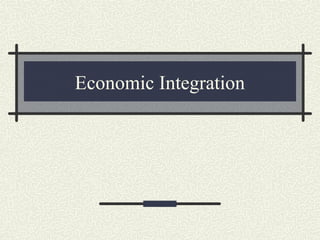Economic integration
•Télécharger en tant que PPT, PDF•
3 j'aime•6,745 vues
Signaler
Partager
Signaler
Partager

Recommandé
Recommandé
Contenu connexe
Tendances
Tendances (20)
Similaire à Economic integration
Similaire à Economic integration (20)
Economic integration
- 2. Introduction Three levels of economic integration Global: trade liberalization by GATT or WTO Regional: preferential treatment of member countries in the group Bilateral: preferential treatment between two countries Regional and bilateral agreements are against the MFN clause (normal trading relations), but allowed under WTO. Visit www.wto.org for regional trade agreements.
- 3. Four stages (types) of economic integration FTA (free trade area): no internal tariffs among members, but each country imposes its own external tariffs to the third country. NAFTA (North America Free Trade Agreement AFTA (ASEAN Free Trade Area) EFTA (European Free Trade Area) Customs union: no internal tariffs and common external tariffs Mercosur (Southern Common Market), CACM (Central American Common Market) CARICOM (Caribbean Community and Common Market)
- 4. Four stages (types) of economic integration Common market: free movement of products and factors (resources), which is customs union plus factor mobility EU (European Union – previously EEC) Economic union: common market plus common currency coordination of fiscal and monetary policy EMU (Economic and Monetary Union)
- 5. Economic effects of economic integration Static effects: Short-term effects (shift of production) Trade creation: production shifts to more efficient member countries from inefficient domestic or outside countries. Trade diversion: production shift to inefficient member countries from more efficient outsiders. Dynamic effects: Long-term effects Cost reduction due to economies of scale Cost reduction due to increased competition.
- 6. Trade deflection: Goods produced in a third country enter a free trade area with the help of a member countries National Sovereignty: Member countries should surrender certain some amount of control related to the important policies like trade, monetary and fiscal policies.